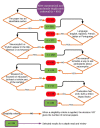The Persistence of Neuromyths in the Educational Settings: A Systematic Review
- PMID: 33510675
- PMCID: PMC7835631
- DOI: 10.3389/fpsyg.2020.591923
The Persistence of Neuromyths in the Educational Settings: A Systematic Review
Abstract
Neuroscience influences education, and these two areas have converged in a new field denominated "Neuroeducation." However, the growing interest in the education-brain relationship does not match the proper use of research findings. In 2007, the Organization for Economic Cooperation and Development (OECD) warned of the misunderstandings about the brain among teachers, labeling them as neuromyths. The main objective here is to observe the prevalence of the neuromyths in educators over time. After two decades of publications of research on neuromyths among in-service or prospective teachers, this work presents a systematic scientific review. To select the articles, we used the words: "teachers," "preservice teachers," "neuromyths" combined with the Boolean data type "and." The search was filtered according to the following criteria: (a) identifiable author, (b) written in English, Spanish, French, Italian, or Portuguese, (c) word neuromyth in title, abstract, or keywords, (d) research with a participant's survey, (e) sample focused on educators, (f) peer-review publication index in JCR, SJR, or ESCI. The documents were found through Web of Science, Scopus, PubMed, Dialnet, ProQuest, EBSCO-host, and Google Scholar. After the search, 24 articles were identified as being of sufficiently high quality for this systematic review. This result highlights that neuromyths are still the subject of attention almost two decades after their definition. The findings present neuromyths as the consequence of a lack of scientific knowledge, a communicative gap between scientists and teachers, and the low-quality information sources consulted by teachers. In addition, the data on protectors and predictors of neuromyths is inconsistent. There is also no standard scientific methodology nor a guideline to determine a new neuromyth. The results show the need to improve the scientific content in higher education and the importance of in-service teacher training. This research justifies the requirement for university professors to be active researchers and to establish a close link with educators from other fields and levels. Neuroeducation will be the bridge that unites scientific knowledge and practical application in education, with a rigorous, standard method for the entire scientific-educational community.
Keywords: educators; neuroeducation; neuromyths; neuroscience; pre-service teachers; teachers.
Copyright © 2021 Torrijos-Muelas, González-Víllora and Bodoque-Osma.
Conflict of interest statement
The authors declare that the research was conducted in the absence of any commercial or financial relationships that could be construed as a potential conflict of interest.
Figures






Similar articles
-
Pre-service Science Teachers' Neuroscience Literacy: Neuromyths and a Professional Understanding of Learning and Memory.Front Hum Neurosci. 2019 Feb 14;13:20. doi: 10.3389/fnhum.2019.00020. eCollection 2019. Front Hum Neurosci. 2019. PMID: 30890924 Free PMC article.
-
Neuromyths in Education: Prevalence and Predictors of Misconceptions among Teachers.Front Psychol. 2012 Oct 18;3:429. doi: 10.3389/fpsyg.2012.00429. eCollection 2012. Front Psychol. 2012. PMID: 23087664 Free PMC article.
-
Preservice teachers' neuroscience literacy and perceptions of neuroscience in education: Implications for teacher education.Trends Neurosci Educ. 2020 Dec;21:100144. doi: 10.1016/j.tine.2020.100144. Epub 2020 Oct 26. Trends Neurosci Educ. 2020. PMID: 33303109
-
Why multiple intelligences theory is a neuromyth.Front Psychol. 2023 Aug 28;14:1217288. doi: 10.3389/fpsyg.2023.1217288. eCollection 2023. Front Psychol. 2023. PMID: 37701872 Free PMC article. Review.
-
On Neuroeducation: Why and How to Improve Neuroscientific Literacy in Educational Professionals.Front Psychol. 2021 Dec 3;12:752151. doi: 10.3389/fpsyg.2021.752151. eCollection 2021. Front Psychol. 2021. PMID: 34925156 Free PMC article. Review.
Cited by
-
Evaluating Pharmacy Faculty's Awareness of Teaching and Learning Myths and Misconceptions.Am J Pharm Educ. 2022 Nov;86(9):ajpe8751. doi: 10.5688/ajpe8751. Epub 2021 Dec 10. Am J Pharm Educ. 2022. PMID: 34893466 Free PMC article.
-
Interventions to Dispel Neuromyths in Educational Settings-A Review.Front Psychol. 2021 Oct 13;12:719692. doi: 10.3389/fpsyg.2021.719692. eCollection 2021. Front Psychol. 2021. PMID: 34721171 Free PMC article.
-
Prevalence of neuromyths among psychology students: small differences to pre-service teachers.Front Psychol. 2023 May 5;14:1139911. doi: 10.3389/fpsyg.2023.1139911. eCollection 2023. Front Psychol. 2023. PMID: 37213389 Free PMC article.
-
Conceptions and Misconceptions: What Do School-Based Speech-Language Pathologists Think About Dyslexia?Lang Speech Hear Serv Sch. 2023 Oct 2;54(4):1267-1281. doi: 10.1044/2023_LSHSS-22-00199. Epub 2023 Sep 6. Lang Speech Hear Serv Sch. 2023. PMID: 37672782 Free PMC article.
-
Effect of a Science of Learning Course on Beliefs in Neuromyths and Neuroscience Literacy.Brain Sci. 2022 Jun 21;12(7):811. doi: 10.3390/brainsci12070811. Brain Sci. 2022. PMID: 35884619 Free PMC article.
References
-
- Ansari D., Coch D., De Smedt B. (2011). Connecting education and cognitive neuroscience: where will the journey take us? Educ. Philos. Theory 43, 37–42. 10.1111/j.1469-5812.2010.00705.x - DOI
-
- Barrios-Tao H. (2016). Neurociencias, educación y entorno sociocultural. Educ. Educ. 19, 395–415. 10.5294/edu.2016.19.3.5 - DOI
-
- Brace C. L. (1993). “Pop science” versus understanding the emergence of the modern mind. Behav. Brain Sci. 16, 750–751. 10.1017/S0140525X00032672 - DOI
Publication types
LinkOut - more resources
Full Text Sources
Other Literature Sources
Miscellaneous

